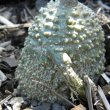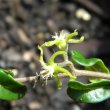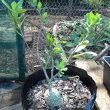Fockea edulis
| Botanical Name | Fockea edulis |
|||||||||||
| Family | Apocynaceae - The Oleander or Dogbane family. |
|||||||||||
| Pronunciation | FOK-ee-uh ED-yew-liss |
|||||||||||
| Common Name(s) |
English: Bergbaroe; Bergkambroo; Hotnotswaatlemoen
Khoi: Kambaroo; Kambroo; Kambro
|
|||||||||||
| Plant Group |
|
|||||||||||
| Plant Size |
|
|||||||||||
| Position |
|
|||||||||||
| General Information |
|
|||||||||||
| Specific Information | Fockea edulis forms a thick grey tuber, known as a caudex, with small wart-like growths (tubercules) all over the surface. In the wild, the caudex is partially or totally buried and tends to grow faster this way. From the top of the caudex thin vine stems branch out , reaching a length of up to 4 meters. and climb on any type of available support. The caudex can grow up to 60 cm in diameter, and the vines reach 4 meters in height. The small seedling forms its caudex on top of the soil. After a year or two it expands deeper and deeper, and finally forms a huge caudex, starting half a meter deep. |
|||||||||||
| Ad Break | ||||||||||||
| Flowers | ||||||||||||
| Description | lightly scented, small vygie-like flowers surounded by a large, thick, spider-like calyx |
|||||||||||
| Season |
|
|||||||||||
| Colour |
|
|||||||||||
| Growth Rate |
|
|||||||||||
| Plant Uses |
|
|||||||||||
| Distribution and Habitat | The distribution ranges of the Fockea species have not been clearly designated but in general, Fockea edulis is found in parts of the southern and eastern Cape, in damp sandy soil. |
|||||||||||
| Planting Suggestions | Fockea edulis is easy to grow although it is usually kept potted as a specimen plant. Although it shows decreased activity in winter, it seldom goes into complete dormancy and always carries some leaves. Conversely it can be deciduous in winter if kept cold and dry. The plant can be watered regularly in warm weather, but care should be taken in winter when it may be prone to rot. Keep reasonably dry and water only enough to keep the tuber from shriveling. It grows well in most soils which must be well drained.. Hardy to -2°C, it will take some frost for a short period of time. Plants grown outdoors may endure relatively wet, cold rainy winters. It prefers sun or light shade, but the tuber should stay constantly in the shade. It is a vigorous twiner and is best trained around a hoop or up a framework as it tends to twine around nearby plants. During summer I keep my plants under 30% shade netting, moving them into full sun during the winter months. |
|||||||||||
| Medicinal Uses | As the name 'edulis' indicates the plant is edible. The huge fleshy tuber was used in dry parts of Southern Africa as an important source of moisture. When eaten it was either consumed fresh or baked and was also used for making a chunky jam. |
|||||||||||
| Ad Break | ||||||||||||







Comments
The Tuin-op-die-Brak Society
The Tuin-op-die-Brak Society in Stilbaai is in the process of completing the development of a FYNBOS PARK (called "Die Tuin op die Brak") in Stilbaai East. We recently discovered a specimen of this 'kambro' and have now planted the caudex in our Park. My question is : Is this plant on the red date list of endangered species ? And is there any information about the nutritional value of its tuber - as a lot of research is currently done on the edible and medicinal fynbos growing on our unique calcareous soils (= kalkrant fynbos).
Regards Mike Steytler Chairman : Tuin-op-die-Brak Society, STILBAAI
Hi Mike
Hi Mike
I checked the Redlist and it appears that this species is categorised as Least Concern, meaning that "Species classified as Least Concern are considered at low risk of extinction. Widespread and abundant species are typically classified in this category."
Here is the link to the website, where you will be able to find the information for any other plants you may wish to assess.
http://redlist.sanbi.org/index.php
As to the nutritional value, I have been able to find no research being done on this species. Reportedly it was used by the San essentially as a source of water as it bridged the gap between the end of the Tsamma melon fruiting season and the start of the next rains.
All the best with your worthy and innovative project.
Kind regards
Lorraine
Hi Lorraine
Hi Lorraine
Thanks for your rapid response and the info you so willingly supplied.
Much appreciated.
Regards
Mike
Lost leaves in summer : (
Hi, I found one of these little guys at a little old green house out in the middle of Nebraska. It was barely holding on to just a few leaves. I repotted and watered it, and it started growing quite rapidly for a few weeks, then, suddenly all the leaves stared turning yellow. I trimmed off the yellow thinking the new growth would take over, but I had no such luck. I called and talked to the gentleman who sold it to me and he mentioned that they go dormant a few times a year and to trim it down about an inch from the base. I did this, but from what I have read online, my edulis should be in rapid growth right now and should only go dormant in the winter. Do you have any suggestions, should I continue waiting, or try watering it regularly again in hopes that it will snap out of it?
Yellowing leaves on Fockea edulis
Hi Jesse
Yes, they only go dormant in winter, not at random times during the year. I really don't like the sound of the yellowing of the leaves. These are plants that live in a semi-desert climate and are not used to regular watering. The first thing I would do is get it out of its pot and check for any signs of rotting. When you have done that, get back to me straight away. It would be pointless for me to give you all sorts of suggestions until we know what is going on with the caudex under the soil. I'll get back to you quickly from there.
Kind regards
Lorraine
Hi Lorraine, Thank you for
Hi Lorraine, Thank you for your quick response : ) I may have been watering it a bit much after it really started to grow. I have spent a good amount of time researching this plant and have read that they can be found in a shaded semi moist environment as well as in very dry environment. Im very new to collecting unusual succulents though, so im definitely learning a whole bunch of awesome stuff. I pulled it, and everything seems to be solid except for the very tip of the larges root. I imagine that Ill need to trim that part off...should I also wash the roots and plant it in new soil?
Root rot on caudex
Hi Jesse
This explains the leaf loss. Use sharp, sterile cutters or knife to cut away all infected bits of root to the point where only healthy and untainted matter is left. Dust with anti-fungal powder or dip into an anti-fungal mixture and leave to dry in a warm, shaded place for four to seven days, depending on the humidity of your area. This is important as the cuts must have time to dry and scar over completely. You can then plant in clean, very well drained soil - a bit more coarse sand mixed into the soil will be good. I get the impression the soil you were using was not draining sufficiently, or the pot was standing in a dish and the water could not drain away. Waterlogged roots are the death knell for any succulent plant.
You are right - they are also found in moister environments but what we call moist may not be as wet as what you might call moist! The bottom line though is drainage. These plants cannot survive if drainage is poor.
If you want the caudex to grow faster, you need to bury the whole root so that the caudex is covered, otherwise it will grow very slowly. You could also plant it in a deeper pot so that the roots are not scrunched up underneath - gives the plant more freedom to gather nutrients.
I think you have caught the damage in time and should be able to save your plant. All the best in your endeavours. Keep me posted.
Kind regards
Lorraine
Fockea edulis
Hello, I just purchased a Fockea on a trip to San Diego. I live in Lake Havasu City, Arizona. We have EXTREME heat here in the summer that sometimes gets into the 120 degrees F. We have had potted plants that that died presumably from the roots being cooked. Do you have any advice about the Fockea's heat tolerance? Thank you.
Fockea edulis
Hi Richard
I have NO idea about heat tolerance, but this plant does originate in an arid region of S.Africa, so it must have some tolerance to heat. But, if I were you (having lived in AZ myself for 4 yrs) and wanted to keep the plant outside, i would keep it under 50% shade cloth.
I love mine ... hope you have as much luck with yours. Write again if i can help.
Fockea edulis heat tolerance
Hi Richard
Fockea edulis does not grow naturally in very arid areas in South Africa. I don't think it would survive the temperatures you describe unless it is kept in shade and given sufficient moisture. Alternatively, pot it and bring it inside during the worst of the summer heat.
Kind regards
Lorraine
Fockea
I bought this one from a web-based retail plant store this summer. it was one of the largest i had ever seen ... that wasn't hundreds of dollars.
some of the bottom leaves of MY Fockea (not SURE if it is a crispa or an edulis) turn yellow and fall off EVERY TIME I WATER it. It needs VERY LITTLE water to not only survive, but prosper. in fact, the vine growth has been so spectacular that I am seriously considering pruning off everything but about 1 foot,
It's vines i have kept trained to a home made trellis and are fairly thick and the caudex occupies about 6" above ground and about 8" below ground.
I keep it inside in an 8" tall/wide round pot, in a southeast facing window supplemented by 4500K CFL's.
Fockea in containers
Hi Wayne
Thanks for your comment. Your plant is clearly happy and healthy.
I think that your plant is most likely F. edulis. The leaves of Fockea capensis (previously F. crispa) are very crinkled. Take a look at these photos of F. capensis: http://redlist.sanbi.org/species.php?species=2663-2
I agree with you that, grown in the sheltered, indoor environment, the plant would need very, very little water. I tend to forget how many people world-wide grow their succulents under such conditions. The watering needs and preferences of the plants I describe are for the plant in its natural habitat. You can imagine the effect of warm, dry winds, plenty of bright sunshine and very fast draining soils would have on this plant in the wild:)
I admit to having little hands-on knowledge when it comes to keeping plants, especially succulents, in pots, but it seems that one of the main problems is that of over-watering.
Kind regards
Lorraine
Fockea
I concur on the drainage. I suspected that mine was NOT potted in soil that was sufficiently fast draining. I de-potted it, finding about one quarter of the root system having succumbed to slimification ... root rot. so I trimmed it until approx one half of the original root system remained, replanted it in a FAST draining soil and it has not only survived, but excelled.
this is all to say that it NEEDS a FAST draining soil, exists well on very little water and is quite robust ... considering what I trimmed off the roots. this is one of my favorite succulents ... out of about 65 pots that I keep inside all year round.
Fockea and root rot
Hi Wayne
Luckily the plant is quite forgiving and can recover from having quite large sections being cut away.
I see you keep quite a lot of cacti. That is an area I keep away from - I am like a magnet to those spines! Apart from which I have enough to keep me busy with just South African plants. I don't see any Euphorbia in your healthy-looking collection. Do you have any?
Kind regards
Lorraine
Fockea, Cacti, Euphorbia & Cacti
It's nice to find someone who has an interest in South African plants.
As far as cacti go, I, also, am a magnet to the spines. I bought a USB microscope (200x) and sharpened, with sandpaper, a large needle so that it had a flat side ... JUST for that reason. Additionally, there are a great number of spineless cacti (Astrophytum comes first to mind) that are extremely attractive and produce flowers on a regular basis.
I have a couple of South African plants and a couple of Euphorbia ... along with Agave. Kelanchoe, Escheveria, Haworthia, Aeonium ... in some 80 pots ... all within my place of abode.
I have some pictures (15 or 16 or so) of my collection that I would love to share with you or anyone else (along with a couple of caudiciforms that I would dearly love help with in regards to identification as I've grown them from seeds).
But am not sure that this forum is most appropriate. Nor am I sure if asking if you have an email address where I could send them is appropriate. But I don't think you need fear my showing up on your doorstep trying to make new friends as I am in the United States and I see from this URL that you are in South Africa ... NOT someplace one "drops by on one's way home from a grocery shop".
You may reply to p.wayne.byerly@gmail.com IF you are interested at all, and/or are willing to help Identify my seedlings.
Hi Wayne
Hi Wayne
Apologies for the tardy reply. You are most welcome to contact me at my email address (kumbulanursery@gmail.com). I am really keen to see your photos and help if I can.
Kind regards
Lorraine
Fockea edulis
You can pick up some research in Renata Coetzee's 2 books on the food history of the Khoi. Some of the fockea were also used to make flour...
A feast from Nature - the food culture of the first humans of planet earth. People can visit Solms Delta, FRanschhoek, to see the plants and learn about them
You can email me for contacts
Discuss this plant
Share knowledge, ask a question or give an experience.